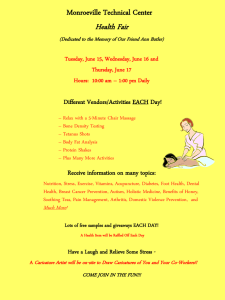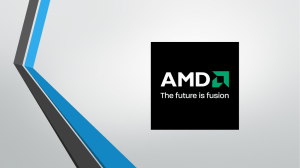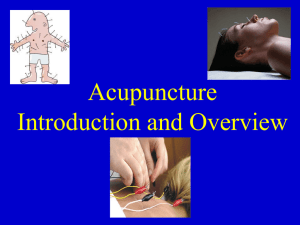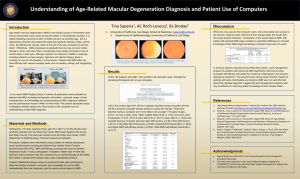American Academy of Acupuncture and Oriental
advertisement
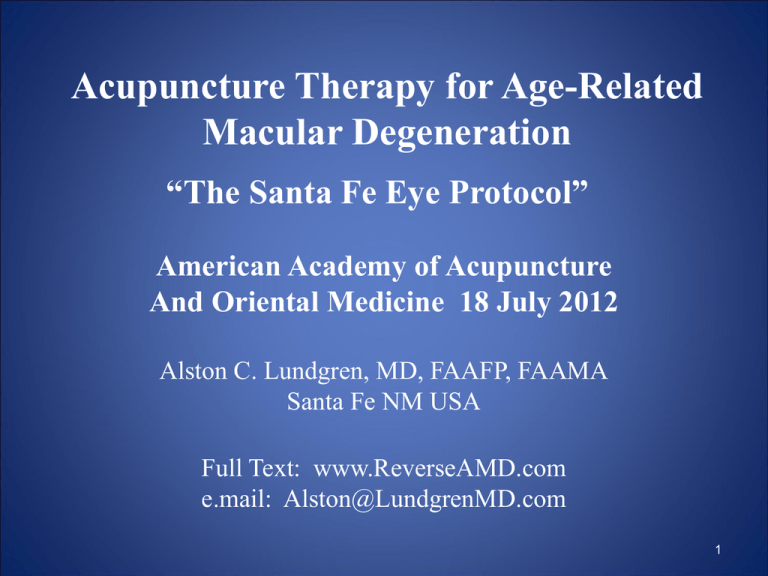
Acupuncture Therapy for Age-Related
Macular Degeneration
“The Santa Fe Eye Protocol”
American Academy of Acupuncture
And Oriental Medicine 18 July 2012
Alston C. Lundgren, MD, FAAFP, FAAMA
Santa Fe NM USA
Full Text: www.ReverseAMD.com
e.mail: Alston@LundgrenMD.com
1
My acupuncture training is mostly European
and Canadian. I am here to share with you
acupuncture principles which may not be
familiar to you .
In particular, I am giving you a tool to treat
many patients who previously have been
unable to be treated – thus helping alleviate
human suffering
2
This AMD treatment is the first situation I
know of where acupuncture treatment can do
something with quantifiable endpoints that
other medical modalities cannot. That means
credibility in conventional Western Medical
eyes
3
Significance
•Millions of persons afflicted with
AMD can now have help.
•This can help legitimize acupuncture
because the condition is quantifiable –
and conventional medicine cannot
help.
4
Presentation outline
•AMD background
•Current conventional treatment
•Description of the Santa Fe Eye Protocol
•Results of the Santa Fe Eye Protocol
•Statistical significance
•Historic and Suggested Treatment
•Technical Details
5
Prevalence : up to 9 million cases in US
Cause: Unknown
Risk factors:
•
Northern and Western European ancestry
•
Ultraviolet exposure
•
Smoking
•
Family history
•
Most significantly, growing older
6
Two varieties
•Dry AMD represents 90 % of cases – usual
course is a slow decline in vision.
•Treatment is limited to hypertension
control, avoiding UV exposure, quitting
smoking, and AREDS vitamins and lutein.
•Wet or Neovascular is 10% of cases - but
the more likely to lead to sudden and severe
vision loss.
7
Ophthalmologists are now able to stop bleeding
by various techniques.
•Thermal laser started 20 years ago – with 3
line vision loss an immediate consequence.
•Photodynamic Therapy – IV Verteporfin
with cold laser – could treat 40 % of wet
AMD cases without the laser 3 line loss.
8
•Anti Vascular Epithelial Growth Factor:
intraocular injections of: Macugen,
Lucentis, and off label Avastin.
•Literature and advertising reports 20+%
of these patients regain lost vision – BUT
most likely the vision gain is the body
reabsorbing blood after leak stops –NOT
the action of the drug itself.
9
Today’s Report on My Work
Since 2001 more than 1500 persons have been
treated with variations of the same protocol
involving several different acupuncture
modalities.
Overall, 85% of patients had an overall
improvement in visual acuity.
10
Basic Definitions
AMD = Age-Related Macular Degeneration
OS = left eye OD = right eye
ETDRS charts (Early Treatment of Diabetic
Retinopathy Study)
•
5 letters each line
•
Logarithmic -3 lines = doubling vision
•
Validated by National Eye Institute
11
The Santa Fe Eye Protocol works on related
retinal conditions - but only half as well.
In Asians, Myopic Degeneration is the most
common type of retinopathy.
In Caucasians it is Retinitis Pigmentosa,
Stargardts, and Best’s Disease plus many
other rare congenital conditions.
12
Reporting Convention
Most of my patients were not local and
came for a week for daily treatments and
were tested on Monday, Wednesday and
Friday before treatment. Thus reports
were standardized to reflect 4 treatments
13
Previously Reported 2010 ICER, Beijing
Total
# individuals
Male/Female
Overall
736
385/351
Population Characteristics
Average age
77.4 years
Age range
44-102 years
Initial Acuity ETDRS Near
20.75
(Snellen 20/96)
Initial Acuity ETDRS Far
24.06
(Snellen 20/84)
14
Overall Results
5
n = 704
Letters
4.8
4.6
n = 710
n = 703
4.4
n = 709
4.2
4
3.8
OS Near
OD Near
OS Far
OD Far
15
Methods
At intake:
• Measure visual acuity using ETDRS eye charts
for both near and distant vision.
• VF-14 subjective measures
• Color screen using HRR isochromic color chart
• Pelli-Robson Contrast Sensitivity measurement
16
Inclusion Criteria
•Must have ophthalmologist diagnosed AMD
•Must have ophthalmologist exam saying no
bleed:
•
Within 3 months if Wet AMD
•
Within 12 months if Dry AMD
•
If any significant vision loss
•Must not be demented
•No seizure history
17
ETDRS Visual Acuity Chart
18
ETDRS Near Chart
19
Pelli-Robson Contrast Sensitivity
Pelli-Robson Contrast Sensitivity
20
Santa Fe Eye Protocol Components
•German Ear Acupuncture
•Canadian Neuroanatomic Acupuncture
•Classic Chinese Scalp Acupuncture
•Yamamoto Scalp Acupuncture
21
Indirect stimulation of specific parts of
brain through ear acupuncture
22
X15 mm needles, 2
cm lateral to midline,
insert down, at
lambdoid suture
Yamamoto CN:30mm
Needles, insert 2 cm
behind hairline, 1 cm
either side of midline.
XMHN # 1, Yamamoto CN needles. Visual cortex
over lambdoid suture is being re-investigated
Direct Electrical Stimulation of
Periorbital area
24
Dry AMD Gains after 4 Tx
6
n=367
n=398
5
n=370
n=402
Letters
4
3
2
1
0
OS Near
OD Near
OS Far
OD Far
25
Wet AMD Gains after 4 TX
6
n = 159
n = 159
Letters
5
4
n = 143
n = 144
3
2
1
0
OS Near
OD Near
OS Far
OD Far
26
Overall Gain vs Intake Acuity
6
Letters
5
n = 280
n = 412
n = 405
n = 241
4
3
2
n = 70
1
0
27
Sum of letters OS and OD, both Near and Far
Vision Gains By Tx Date
20.5
20
19.5
19
18.5
18
17.5
17
16.5
16
15.5
15
n= 32
n = 80
n = 128
n = 489
n = 69
Pre Nov Nov 07 - Apr 08 - Nov 08 - Sep 09 07
Apr 08 Oct 08 Sep 09 Mar 10
28
Hard to Quantify Gains
•Distortions lessen.
•Scotomas diminish or disappear.
•Less light needed to see.
•Sensation of a film over eyes decreases.
•Colors become more vibrant.
29
Function vs Physical Changes
Most patients and I focus on function. For many
retinologists, the more important issue is changes
in retinal photographs , angiograms or OCT
measurements . A few patients have reported
significant gains in those tests, but I have not
performed them. Those studies should be
performed by an independent, academic center
in a systematic way.
30
DURABILITY
•An IRB study is underway to determine
durability and also late gains. Release of
records forms have been signed – but it is a
massive effort yet to be done.
•Anecdotally, patients have retained vision
gains upwards of 5 years.
•When there are losses, a big portion of the
time they are associated with a CVA. Rarely
is it a hemorrhage – but that is the big
concern.
31
Late Gains
A significant portion of patients report late
gains – scotomas clearing, more colors,
clearer vision, etc. Since most patients are not
local, the next stage of research is obtaining
vision records from treating eye doctors.
32
Risks
To date only black eyes – which always
spontaneously resolve.
There is a concern that there might be an
increase in the number of bleeds in
persons with wet AMD. Only 2 cases
have occurred near the time of treatment.
Periorbital infections are rare – but must
be treated aggressively with antibiotics.
33
Statistical Significance
Central Limit Theorem: Standard
deviation of a group of N independent
distributions equals the standard
deviation of an individual divided by
the square root of N.
34
Typical test-to-test variation for visual acuity is
1 ½ lines with 95% confidence. That is, one
standard deviation = 0.75 lines.
For a 100 member group of those individuals,
the standard deviation is 0.1 x 0.75 or 0.075.
For groups the size in this presentation, the p
value < 0.001 that the improvement is from
random variation.
The results are real!!
35
Conclusion
The acupuncture protocol reported here
increased visual acuity for both dry and wet
varieties of AMD much more than can be
explained by random chance or test
variation.
36
Research Questions
•What electric frequency to use?
•Duration of each treatment?
•Interval between treatments?
•Are there observable changes in retinal
photographs/angiograms?
•Optimal needle placement?
37
Santa Fe Eye Protocol
2012 Suggested Needle
Placement and Technical Details
38
Methods
• At intake:
• Measure visual acuity using ETDRS eye charts
for both near and distant vision
• Pelli-Robson Contrast Sensitiviy measurement
• Color screen using HRR isochromic color chart
• VF-14 subjective measures
German Ear: Bilaterally gold ASP at Eye, CN 2, Pineal,
Diazepam Analog and Interferon and steel mastoid
Scalp: XMHN#1, 15 mm x 0.20 mm needle (-) at
lambdoid to ipsilateral Yamamoto CN line (+)
Canadian Neuroanatomic 0.20 mm x 15 mm Nasal
infraorbital ridge (-) to 0.20 x 30 mm temporal
supraorbital ridge (+)
Temporal infraorbital ridge (-) to nasal supraorbital
ridge (+)
40
German pineal, CN 2, pineal, diazepam
analog, interferon and steel ASP needle
behind earlobe
German Ear
Simplified protocol:
Both ears the same: non dominant ear
gold at named Pineal, Diazepam Analog,
Interferon, CN 2 and Eye point with steel
on mastoid earlobe opposite CN 2.
This represents “cookbook recipe” as
opposed to practitioners needing to know
German Auricular.
42
Be sure to add gold ASP studs
Bilaterally at eye and CN 2 points
And a steel ASP on mastoid
Earlobe to form a Bahr Forceps
43
Scalp
Modified XMHN#1 using 0.20 x 15 mm
needles oriented not to fall out
As of 2012 my preferred approach is (-) at
lambdoid suture over visual cortex, 2 cm
from midline to (+) at ipsilateral
Yamamoto CN site 1 cm lateral to
midline. This starts 2 cm cephalad of
hairline toward forehead
45
X15 mm needles, 2
cm lateral to midline,
insert down, at
lambdoid suture
Yamamoto CN:30mm
Needles, insert 2 cm
behind hairline, 1 cm
either side of midline.
XMHN # 1, Yamamoto CN
needles, visual cortex over
lambdoid suture
Direct Electrical Stimulation of
Periorbital area
Suggested Eye Needle Placement
Nasal infraorbital ridge (-) to temporal
supraorbital ridge (+) and
temporal infraorbital ridge (-) to nasal
supraorbital ridge
Needles arranged such that electric current
will flow through the whole retina –
including the macula
48
Old array – no time for new slide.
Crisscross pattern (-) nasal infraorbit to (+)
temporal supraorbit, (-) tempral infraorbit
to (+) nasal supraorbit
ENERGY
This is my historic protocol. Going
forward I will simplify my protocol by
eliminating this part except in those
persons suffering excess fatigue. I started
it because older persons coming from sea
level to Santa Fe’s 7000 foot elevation
suffered.
50
Abandoned Energy Component
SP 4 connected to KI 3 (-) to ST 30 connected
to CV 2/4(+), CV 12, 17, tack at PC 6 with
return LI 11 (-) to ST 36 (+)
This is Chong Mo expanded – to add energy to
the system, with a French Energetics return
that stimulates the immune system. These
circuits alone are a very powerful combination
to add energy and stimulate immune system
in a very large number of clinical situations.
51
{KI 3 to SP 4} (-) to {CV 2/4 to ST 30} (+),
tack or needle at PC6
LR 3 (-) to LR 9 (+)
Return: LI 11 (-) to ST 36 (+)
Precautions
•Periorbital infections MUST BE
aggressively treated with antibiotics
•Seizures are a contraindication
•Demented persons do not respond well
and cannot validly report
53
Helpful Pointers
• Anti-coagulation is not a contraindication
•
Black eyes are very common – but
always resolve spontaneously. I always
apply an ice pack for 5 – 10 minutes
after each treatment
54
Technical Details
I have no business interest with any supplier
ETDRS and Pelli-Robson charts from several
sources. Precision Vision, La Salle, IL is one.
Needles: Many sources. I use Accuglide from
Helio and gold ASP semipermanent needles from
Lhasa
55
Stimulators: Most stimulators do NOT deliver the
frequencies indicated. Ito and several Chinese
devices are commonly off by 50%. Pantheon
Electric (Santa Monica, CA) devices cost twice as
much but are exactly correct as tested by
oscilloscope. They also will set units at Nogier
frequencies.
Electrodes formerly from Helio, now from Lhasa.
Better ones are small wires, 3 prongs on one clip and
2 on the other.
56
Thank you for your attention.
Full Text Posted: www.reverseAMD.com
Alston@LundgrenMD.com
57
